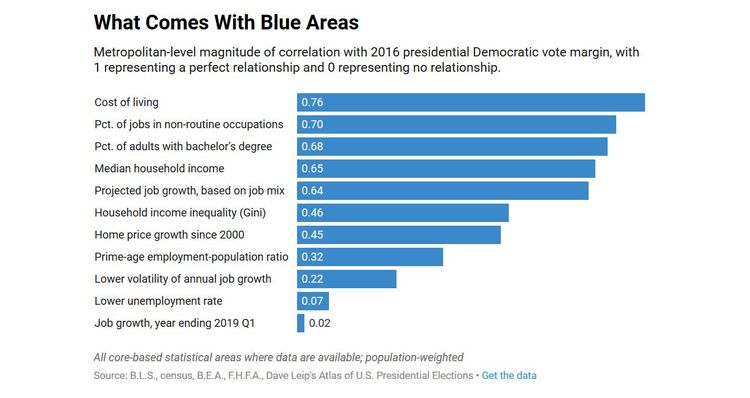


By Steve Sailer
11/14/2019
Earlier, from Steve Sailer: "Affordable Family Formation" — The Neglected Key To GOP’s Future
From The New York Times:
Red and Blue Economies Are Heading in Sharply Different Directions
On the surface, there seems to be parity between Democratic-leaning and Republican-leaning metro areas, but take a closer look.By Jed Kolko
Nov. 13, 2019At a quick glance, red and blue metropolitan areas are performing equally well on average in the most watched indicators of labor market health.
Employment growth in the year ending in the first quarter of 2019 was 1.4 percent in both Democratic-leaning and Republican-leaning metro areas, and the unemployment rate in both types of places is roughly equivalent.
Silicon Valley (blue) is booming. So is Provo, Utah (red).
But below the surface, red and blue local economies are worlds apart on enduring, fundamental measures that determine their future prospects and their biggest economic challenges.
The correlations between deeper economic measures and how the contrasting metro areas voted in 2016 are striking.
In bluer metros, more residents have college degrees: The 10 large metros with the highest educational attainment each voted for Hillary Clinton by at least a 10-point margin. Median household incomes are higher in bluer metros even after adjusting for the cost of living, which is higher in bluer metros as well. (Metro area is a better measure for a local labor market than a neighborhood, city, county or state.)

This is stuff I figured out in late 2004– early 2005.
… Home values have risen more in bluer metros than in redder ones. And blue metros have a higher prime-age employment-population ratio, even though the unemployment rate varies little by partisanship. That’s because red metros have a higher share of prime-age adults who are not in the labor force and therefore aren’t counted in the unemployment rate.
That would be bad if you were out of the labor force because you are a junkie, but it would be good if you were out of the labor force because you have 3 small children and your husband makes enough that you can stay home with them.
But there are a few places that vote differently than you’d expect from their local economic fundamentals. Colorado Springs and the Provo-Orem area, for instance, have education levels and an occupation mix more typical of blue metros but voted for Donald J. Trump in 2016 by a wide margin. On the flip side, Stockton, Calif., and El Paso look more like red metros economically but voted for Mrs. Clinton.
Why do some metros vote differently than their economics might suggest they would? Race, ethnicity and religion. Metros that vote Democratic despite having lower education and a job mix more typical of redder metros tend to have large Hispanic populations, including many in inland California and on the Texas border. Metros that vote more Republican despite having higher education and a blue-metro job mix tend to be whiter. (Colorado Springs also has a large evangelical population, and Provo-Orem a large Mormon one.) …
Jed Kolko is the chief economist at Indeed.com. You can follow him on Twitter at @JedKolko.